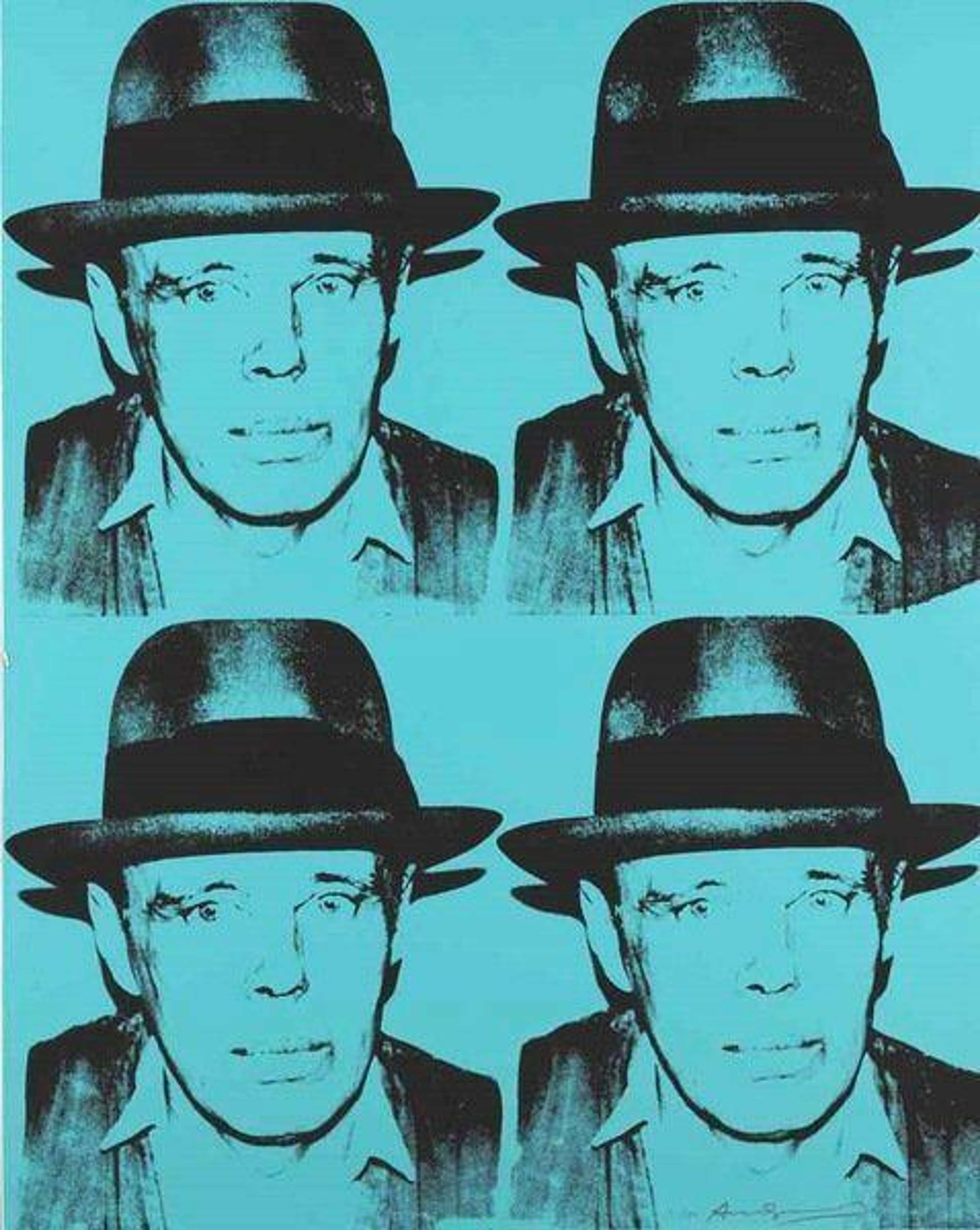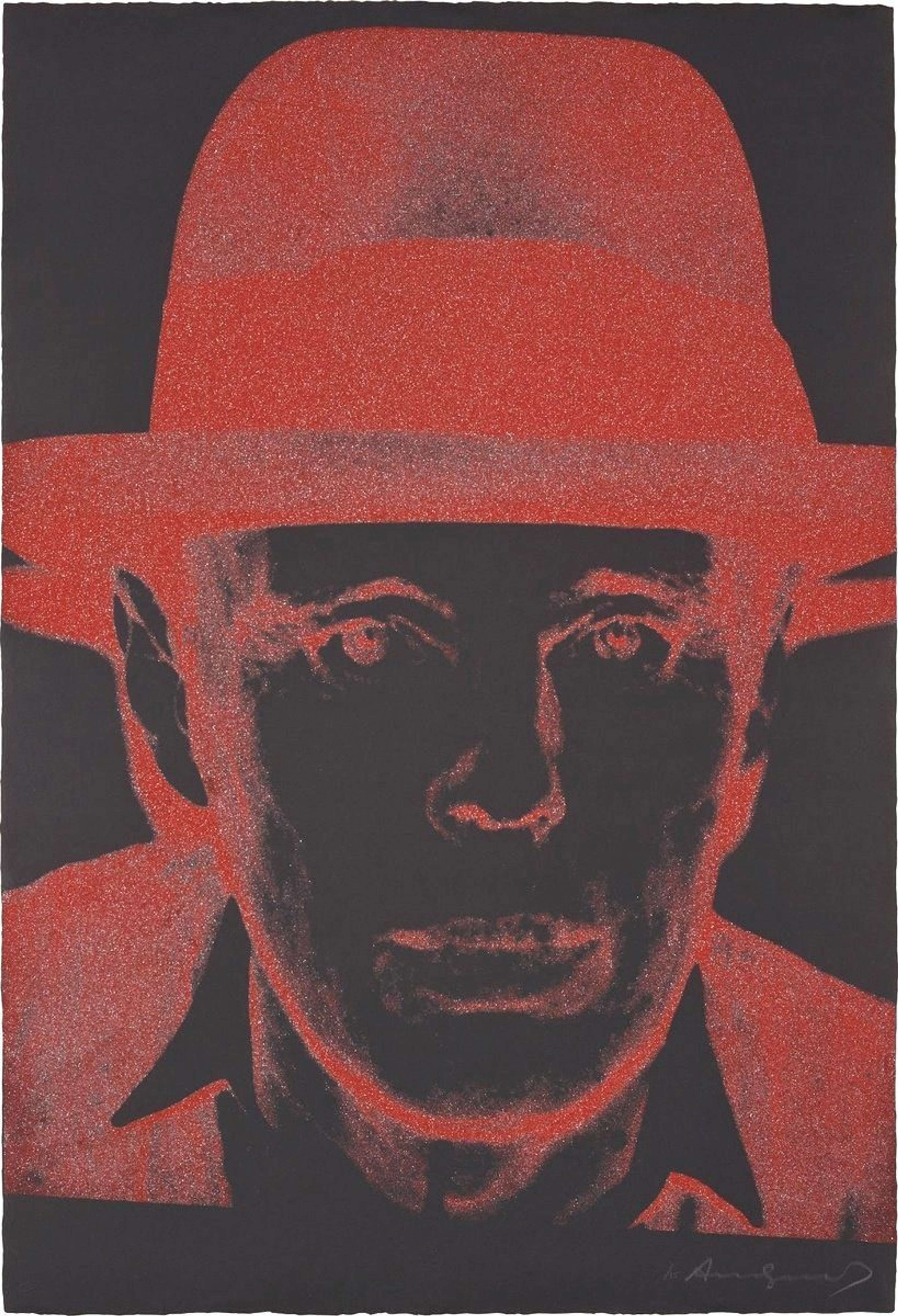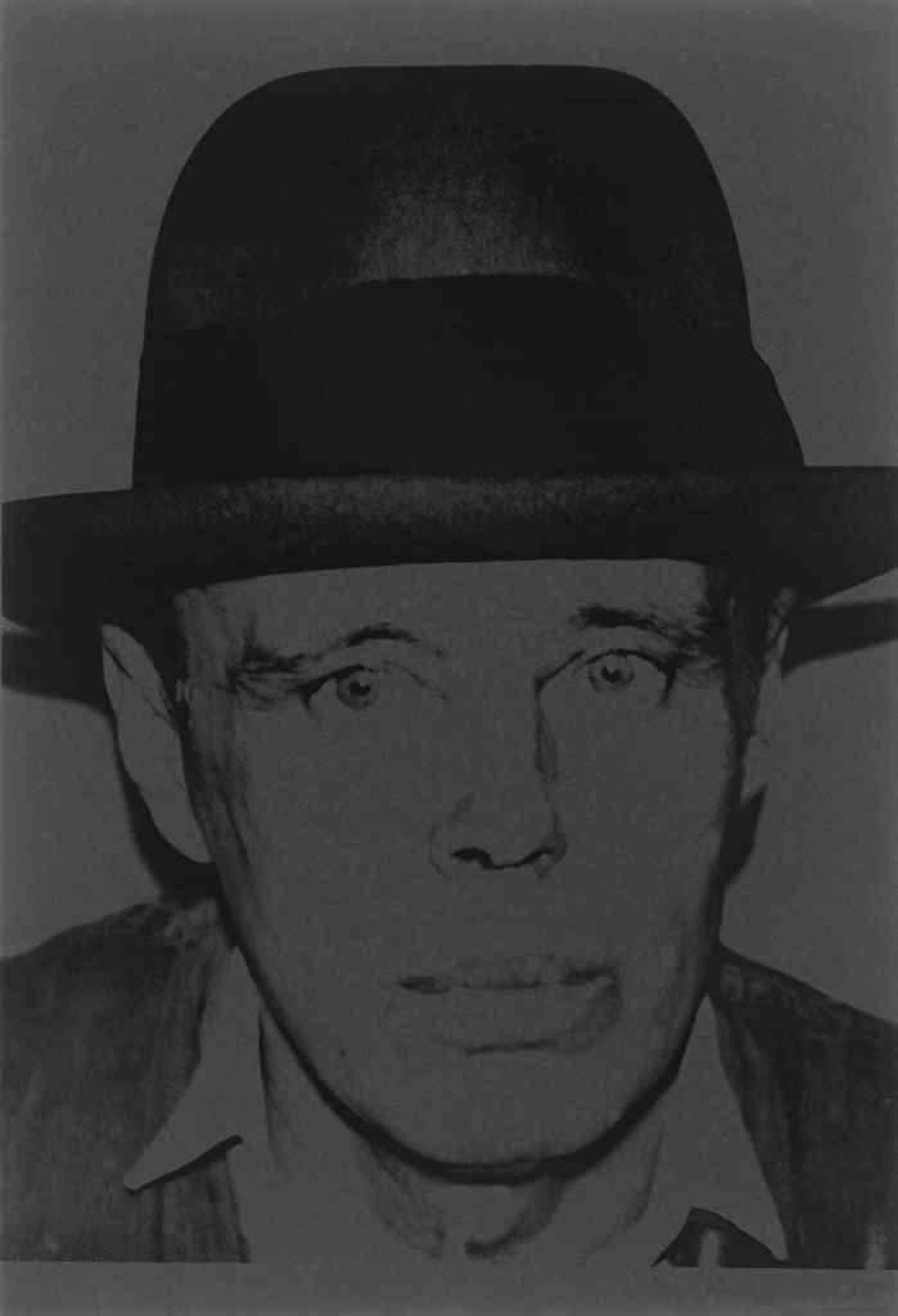 Joseph Beuys In Memoriam (F. & S. II.371) © Andy Warhol 1986
Joseph Beuys In Memoriam (F. & S. II.371) © Andy Warhol 1986
Interested in buying or selling
Andy Warhol?

Andy Warhol
487 works
Created in 1980, the Joseph Beuys screen print series is Andy Warhol's homage to one of the most influential artists of the Post-War period. The series brings together two major figures of 20th century art, uniting the founders of the Fluxus and Pop Art movements.
The series is an homage to fellow artist Joseph Beuys.
 Joseph Beuys (F. & S. II.245) © Andy Warhol 1980
Joseph Beuys (F. & S. II.245) © Andy Warhol 1980In this sizeable portfolio, Warhol represented the German artist, teacher, and theorist Joseph Beuys (1921-86). The screen print series brings together two titans of Post-War art, and illuminates the mutual respect these two artists had for one another - though their approach to ”Art” was very different. Across the entire series, Warhol duplicated a single portrait of Beuys gazing directly out to the viewer. Many prints in the series, like Joseph Beuys (F. & S. II.245), use an inverted colour palette, emphasising the intensity of Beuys' persona.
Beuys was one of the most influential artists of the 20th century.
 Burkhard von Harder, German Artist Joseph Beuys, Cafe Florian, Venice 1983 c Burkhard von Harder, CC BY-SA 4.0
Burkhard von Harder, German Artist Joseph Beuys, Cafe Florian, Venice 1983 c Burkhard von Harder, CC BY-SA 4.0Beuys was something of the modern polymath. He was a sculptor, performance artist, teacher, radio operator, theorist - the list goes on. Today Beuys is regarded as one of the most influential artists of the Post-War period, his innovations in performance art and ”social sculpture” influencing generation after generation of artists. Beuys frequently described his work as ”actions”, each performance and sculpture designed to encourage thought and democracy. Though Warhol's approach to art was quite unlike Beuys’, this series is a testament to the his legacy and the seismic influence of his theoretical work throughout the second half of the 20th century.
Warhol and Beuys collaborated.
 Joseph Beuys (F. & S. II.242) © Andy Warhol 1980
Joseph Beuys (F. & S. II.242) © Andy Warhol 1980In 1985, Warhol and Beuys collaborated alongside Japanese artist Kaii Higashiyama. Together, the trio engaged in a project titled ”Global-Art-Fusion”, whereby the artists faxed their drawings around the world in a call to peace during the Cold War. The project was an unusual departure for Warhol, but highlights the unifying nature of art during periods of socio-political uncertainty.
The series represents Beuys in his iconic fedora hat.
 Joseph Beuys (F. & S. II.247) © Andy Warhol 1980
Joseph Beuys (F. & S. II.247) © Andy Warhol 1980Just as Warhol was renowned for his white blonde hair and clear frames, Beuys was recognisable for his felt suits and fedora hat. In this series, Warhol captures Beuys in his iconic fedora, which is cropped out of the composition to provide emphasis on his penetrative gaze.
Beuys turned his attention to politics in the 1960s.
 Joseph Beuys (F. & S. II.243) © Andy Warhol 1980
Joseph Beuys (F. & S. II.243) © Andy Warhol 1980The ”Global-Art-Fusion” project of 1985 was certainly not Beuys’ first foray into the world of politics. Raised under National Socialism and a member of the Hitler Youth, Beuys broke free from the strictures of this regime in adulthood and used his art to better the world. During the late 1960s, Beuys co-founded the Green Party (Grünen) in Germany, pledging himself to promoting democracy and ecological issues. Though Warhol was famously considered politically ”neutral”, he said of Beuys: “I like the politics of Beuys. He should come to the US and be politically active there. That would be great... He should be President.”
Beuys was founder of the Fluxus movement.
 Joseph Beuys: State III (F. & S. II.244) © Andy Warhol 1980
Joseph Beuys: State III (F. & S. II.244) © Andy Warhol 1980Beuys was a strong believer that critical thinking was an art form in and of itself. By probing and talking about Beuys’ work, the artist believed his viewers became part of the artwork or ”social sculpture”. Beuys found commonality with the Lithuanian/American artist George Maciunas, who founded the Fluxus movement in 1960. The movement push the boundaries of what art could be, and was one of the most influential movements in developing performance art and ”happenings” - which shaped much of Beuys’ own oeuvre.
Warhol and Beuys took very different approaches to their art.
 Joseph Bueys State II (F. & S. II.243) © Andy Warhol 1980
Joseph Bueys State II (F. & S. II.243) © Andy Warhol 1980Though Warhol and Beuys collaborated together and shared an admiration for one another, their approaches to art were vastly different. Warhol's work famously had consumerism and the cult of celebrity at its core. Warhol himself was surrounded by a star-studded entourage, and led a lifestyle befitting of an A-lister.
Beuys, on the other hand, used his art to promote democracy, freedom of thought, and was much more interested in his viewers becoming part of his work. Where Beuys’ work sought to shape social consciousness, Warhol's work documented it. Despite their differences, however, the pair were clearly inspired by one another.
The series was created from a Polaroid photograph snapped by Warhol.
 Joseph Beuys (F. & S. II.246) © Andy Warhol 1980
Joseph Beuys (F. & S. II.246) © Andy Warhol 1980Like many of Warhol's portrait series, like Mick Jagger and Ladies And Gentlemen, the Joseph Beuys series was started with a Polaroid photography session between artist and sitter. Warhol snapped this memorable image of Beuys in 1979, and used it as the basis for this series in 1980.
Warhol and Beuys only met a handful of times.
 Joseph Beuys (F. & S. II.244) © Andy Warhol 1980
Joseph Beuys (F. & S. II.244) © Andy Warhol 1980Though Warhol and Beuys collaborated, and Warhol dedicated this entire series to him, the pair met sparingly. However given the breadth of this screen print series, we can see that Beuys clearly had a strong and enduring influence on Warhol - even if his own take on the meaning of art was divergent from Beuys’.
Warhol produced a special edition of the print to commemorate Beuys' death.
 Joseph Beuys In Memoriam (F. & S. II.371) © Andy Warhol 1986
Joseph Beuys In Memoriam (F. & S. II.371) © Andy Warhol 1986Created six years after the Joseph Beuys series, Warhol created his Joseph Beuys In Memoriam (F. & S. II.371) print to commemorate Beuys’ death. Unlike other prints in the earlier series, Warhol depicted Beuys’ portrait against a camouflage background - giving a ghostly and poignant effect.
